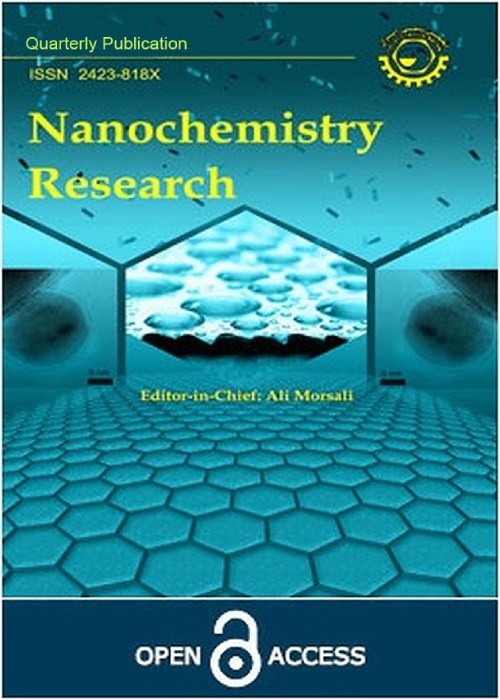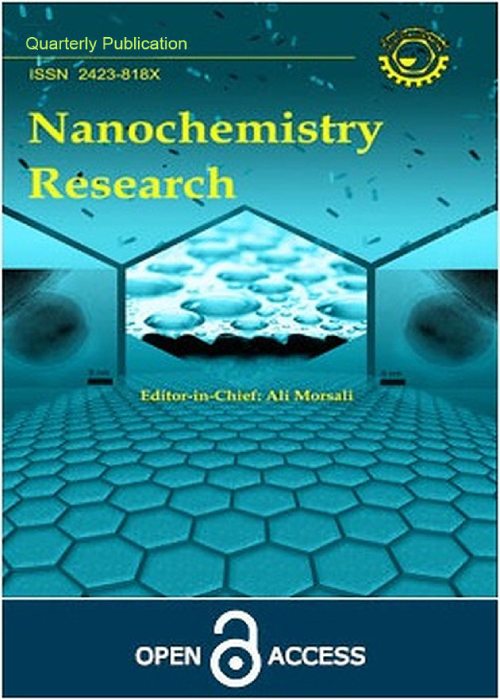فهرست مطالب

Nanochemistry Research
Volume:8 Issue: 2, Spring 2023
- تاریخ انتشار: 1402/04/03
- تعداد عناوین: 8
-
-
Pages 87-94
In the present study, graphene oxide nickel-titanium layered double hydroxide (NiTi-LDH/GO) was synthesized. NiTi-LDH/GO was used as a fiber coating for the determination of phenolic compounds for headspace solid‐phase microextraction methods in water samples. These extracted components were introduced into a gas chromatography-mass spectrometry (GC-MS) injection port for further analysis. The following analytical merits were used under optimal conditions: temperature of extraction: 80 ºC, desorption duration: 2 min, extraction time: 40 min, temperature time: 270 oC, salt concentration: 10% (w/v), 0.01–100 µg L-1 and 0.004-0.09 ng mL-1 for dynamic linear rang (DLR) and limit of detection (LOD), respectively. The repeatability under optimal conditions for one fiber (n = 3) is given as the relative standard deviation (R.S.D. %) which was between 6.5 % and 9.9% for these compounds. The results of the experiments clearly indicate that the NiTi- LDH /GO nanostructure fiber is an appropriate choice for HS-SPME of phenols analysis. By combining HS-SPME using NiTi- LDH /GO nanostructure fiber and GC-MS, low LODs can be achieved which can be used for determining phenols from water samples.
Keywords: Graphene oxide, Layered double hydroxide, Microextraction, Phenols -
Pages 95-105
An adsorption activity of the functionalized magnetic nanoparticles with chitosan-melamine as a sorbent were studied for removal of dyes contaminants from aqueous solution. The morphology, structure, and size of the MA-CS@Fe3O4 nanocomposite have been investigated. The synthesized pH-sensitive adsorbent successfully adsorbs cationic dyes such as basic red and methyl blue. Adsorption experiments were carried out as batch studies at different contact time, pH, initial dye concentration, and adsorbent dosage. The dye adsorption equilibrium was rapid as it was achieved under 30 min of contact time with 5 mg adsorbent. The equilibrium data were analyzed by nonlinear Langmuir and Freundlich model for BR and MB adsorption. The best fitting results were achieved for Langmuir model and confirms that the adsorption of dyes are monolayer and the surface of MA-CS@Fe3O4 sorbent is homogeneous. The pseudo-second-order kinetics can describe the adsorption process for both MB and BR. Thermodynamic study showed that the adsorption was a spontaneous and endothermic process.
Keywords: Chitosan, Fe3O4 nanoparticles, Melamine, Dye pollutants, magnetic sorbent -
Pages 106-116
In this work, the potentials of Sc-, Ti-, and Zn-doped BN nanosheets for adsorbing and detecting the amantadine drug were studied by using density functional theory (DFT), natural bond orbital (NBO), and quantum theory of atoms in molecules (QTAIM). The amantadine adsorption on the considered doped BNNSs was chemisorption. The strongest adsorption was related to the amantadine adsorption on Sc-doped BNNS. Among the considered doped BNNSs, only Sc-doped BNNS can be employed as a suitable electronic conductivity detector for amantadine in the environment. In addition, all the considered doped BNNSs, may be proper for work function type in detecting the drug.
Keywords: Amantadine, Adsorption, Detection, Transition metal doped BN nanosheet, DFT -
Pages 117-121
In this study, we evaluated aerosol transmission of two wild edible mushrooms. They were Calvatia booniana and was Terfezia claveryi Chatin with the spore sizes of about 1 to 2 µm and 20 µm, respectively. First, we stained both types of spores and carefully recorded the morphological shape of the two microparticles, which were different in size and cytological characteristics under an optical microscope. We pumped the solution containing both large and small spores in tunnels of 3 x 3 x 3 cubic centimeters and 10 meters long. After half an hour we examined the presence and frequency of spore particles settling on the glass placed under the microscope. Based on the results, the larger micro particles with the diameter of 20 µm can diffuse about 60 to 70 cm, while small microparticles (2 µm) were spread about 200 cm. Since the COVID-19 is about 100 nano meters in size and assumes a direct ratio of size with the particle mass (m), using the classical kinetic energy formula (½ mv2), we estimated its diffusion more than 8-9 meters in room air condition. Thus, the results indicate that it is highly important to know that the Coronavirus 2019 and similar viral agents spread through air more than 8-9 meters; therefore, appropriate control measures should be applied to prevent the diffusion of the SARS-CoV-2 and similar epidemics.
Keywords: Airborne transmission, Micro particles, Mushroom spores -
Pages 122-133
In this article, the history of metal three-dimensional (3D) printing technology and various types of methods and their advantages and disadvantages were investigated. Selective laser melting (SLM) were compared in terms of consumables, working methods, limitations, capabilities and applications. By examining each method, it can be seen that the superiority of each of them depends on the materials intend to use basis of any type of light or heavy parts. The prepared sample by SLM process belongs to the family of 3D printing is fusion powder. Also, the materials used in both processes are metals that are granular. This technology is suitable for complex parts that cannot be made by traditional methods with high cost with excellent mechanical properties for the industry, plastic and dentistry application. This technique used metal 3D printing technologywith various porosity. Metal printing provides more benefits to industries every day. This technology have its own disadvantageous which is not suitable and cost-effective for manufacturing parts with traditional methods.
Keywords: 3D printing, Selective Laser Metlitng, Dentistry application, Titanium-6Al-4V -
Pages 134-140
In this work, copper oxide nanoparticles were efficiently synthesized using a simple and environmentally friendly sol-gel process and studied their degradability of reactive blue 21 dye and antibacterial properties. To characterize the synthesized CuO nanoparticles, powder X-ray diffraction (XRD), Brunauer Emmett Teller (BET), transmission electron microscope (TEM), field emission scanning electron microscopy (FESEM), and Differential reflectance spectroscopy (DRS) analysis were used. The particle size was determined using the TEM technique to be roughly 25 nm. The optical band gap of CuO nanoparticles was calculated using the Tauc relation from the absorption spectra and was determined to be about 2.04 eV. The CuO NPs showed good photocatalysis activity towards the Reactive Blue 21 dye as an organic pollutant so that 86% of RB21 was removed in 60 min in room condition and visible light region. CuO NPs were evaluated for antibacterial efficacy against including Gram negative (Escherichia coli, Salmonella typhimurium, Proteus mirabilis, Pseudomonas aeruginosa) and Gram positive (Staphylococcus aureus, Enterococcus faecalis) bacteria.
Keywords: Copper oxide, Green synthesis, Antibacterial activity, Photocatalytic activity -
Pages 141-151
The use of plant extracts as reducing agents in the synthesis of metal and metal oxide nanoparticles has come into prominence due to their procedural simplicity, precursor’s eco-friendliness, and cost effectiveness. The phytochemicals in plant extracts works as a reductant when mixed with metal salt solution. In this study, we compared the percentage yields of copper oxide (CuO) nanoparticles synthesized using aqueous leaf extracts of Psidium guajava (guava), Terminalia catappa (tropical almond), Cymbopogon citratus (lemon grass), and Tithonia diversifolia (mexican sunflower) at varying volume-ratios with copper sulphate standard solutions. The optimization study of the biosynthesis mixtures revealed that the mixture with the volume-ratio 1:1 of Cu salt : plant extract gave the highest yields in all samples. The nanoparticles were characterized using Fourier-transformed infra-red (FT-IR) to confirm characteristic bands expected of metal oxide particles at the finger print region. The transmission electron microscope (TEM) presented the average sizes within the range of 3.68 and 7.92 nm, while the energy dispersive X-ray Spectroscopy (EDS) confirmed their high purity due to the absence of other elements except carbon. The biosynthesized nanoparticles are highly pure with their small sizes and this makes them suitable for adsorption applications.
Keywords: Aqueous leaves extracts, CuO nanoparticles, EDS, FTIR, TEM, Percentage yield -
Pages 152-163
The augmentation in population leads to increase food demand and respectively the utility of fertilizers and pesticides. Due to excess utility of chemical fertilizers and pesticides major environmental and health issues were observed. . Recent developments in Nano agrochemicals have attained interest of researchers due to its eco-friendly nature and cost-effectiveness. Here, in this article we reviewed the advantages of nano-tools being nanofertilizers and nanopesticides over the conventional mineral fertilizers and pesticides and the developments in nano-agrochemicals along with their applications in farming industries such as improving the crop production, minimizing the input and maximizing the output, solving agronomy problems being better food yield together with preservation. This review comprises latest impacts of nanotechnology in farming industries, nano-agrochemicals versus conventional agro-chemicals and nanomaterial as pesticides and fertilizers and sustainable development. Nano agrochemicals in form of Nanopesticides, Nanofertilizers, Nanobiofertilizers, Green Nanopesticides as well as Metallic nanopesticides are emerging as a new product for industry.
Keywords: Agriculture Nanotechnology Nano, agrochemicals Nano, pesticides Nano, fertilizers


